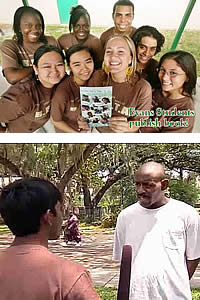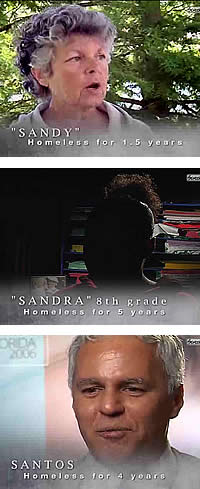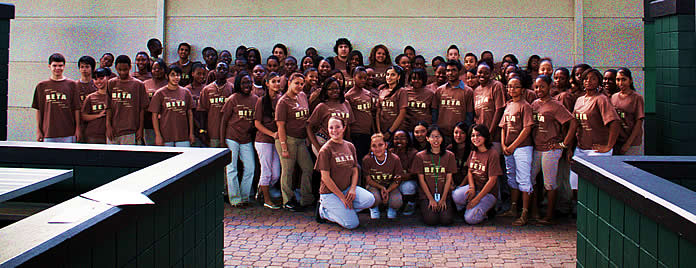
Photos (left to right): Homeless man and woman - Central Florida Coalition for the Homeless; “An Unpredictable Saturday” - Maynard Evans HS Beta Club
by Barbara Cervone
ORLANDO, FL—The calculus of living paycheck to paycheck in America keeps getting harder. Pay the rent but drop the life-saving medication. Skip lunch so there’s enough for dinner. Give up the phone but hold onto the car. We hear it often: Many Americans are just one or two paychecks away from being homeless.
Nineteen-year-old Shardy Camargo in Orlando, Florida knows this well. She and her mother—who worked for more than ten years as a minimum-wage cashier at McDonald’s—lost everything they had when Shardy was a high school freshman. After a failed try to find stability with relatives in the Dominican Republic, they joined the estimated two to three million homeless Americans who live day-to-day in shelters, cars, makeshift tents, or on the streets. Roughly 40 percent are families with minor children.
“Going into middle school, I didn’t know we had financial problems,” said Carmago. “I thought it was normal. My mother kept applying for food stamps and kept getting rejected because they said she made ‘too much,’ even though we were having to skip meals. Then, suddenly, even the little bit we’d built up went away.”
When she and her mother got back on their feet, Carmago became a regular volunteer at Orlando’s Coalition for the Homeless. At Maynard Evans High School, she joined the Beta Club, a national community-outreach program. With more than 45 classmates, she started what has become a multi-year project to tell the stories of Orlando’s homeless—in print and video.
Click here to see Everyone Has a Story to Tell on the SchoolTubeChannel
“In my mind, I’m really not homeless, I’m not rock bottom,” said Tommy, one of nine people featured in the students’ documentary film Everyone Has a Story To Tell. He worked at FedEx for 14 years before alcoholism put him out of work and on the streets. “I’m down, but I’m not out.”
Elevating the homeless
Jennifer Bohn, the Maynard Evans social science teacher who sponsors the Beta Club, saw a perfect club project in the students’ desire to put a human face on homelessness. For the third year in a row Florida leads the country in violence against the homeless, with teens often the perpetrators, and Orlando is among the nation’s most violent cities for the homeless. Many of the high school’s 2,000 students, almost all minority and on free or reduced lunch, come from families that are themselves two paychecks from being on the streets. And the stigma attached to attending this high school, not unlike the stigma attached to living in a shelter, is both inaccurate and unkind.
“By elevating the homeless,” Bohn said, “the students would elevate themselves as well. By bringing awareness to the epidemic of homelessness, they might contribute in a small way to breaking the chain of poverty.”
The students decided to interview men and women at the city’s homeless shelter, and Carmago’s strong ties to the people living there provided remarkable access. The students interviewed 30 residents, wrote up their stories, and published them in a book (which can be purchased online, with profits going back to the Orlando Coalition for the Homeless).
Then, thanks to a grant from Disney, the Beta Club turned their passion and talents to creating a documentary video. As with the book, their goal was to punch through the stereotypes of the homeless—that they are uneducated, unmotivated, and unfit. They also wanted to feature the stories of youth who are homeless, like Shardy Carmago.
“For the film we went out looking for individuals who were willing to tell their story,” explained senior Nickelle Smith, current president of the Beta Club. “There’s a lake in Orlando that attracts a lot of homeless people and that’s where we started.”
“We were surprised how many people we asked actually wanted to be interviewed, to be part of the film,” added Steev Bilius, a junior. “They saw it as a chance to have their voices heard. They sensed the impact their words and stories would have.”
Over the course of six months, the students took the video from start to finish: creating a storyboard, finding folks to interview, then filming their interviews, editing, selecting music, and creating graphics. The results are extraordinary. The film is professional in every sense, and the stories of the nine homeless individuals that fill these 32 minutes are breathtaking in their honesty and strength.
Everyone has a story to tell
The video introduces Sandy, for example, who has been homeless for one and a half years and was “brought up in a Midwestern American home, with good values.” After 18 years of marriage she divorced her alcoholic husband and worked for 17 years as a massage therapist. When her parents became ill, she left her job and moved to take care of them, but as the stress piled up she found herself on the brink of mental illness. Her parents recovered, but kicked her out as her symptoms became worse; her car was stolen, and soon she found herself—unbelievably—on the sidewalk. 
Still, she remains upbeat: “What breaks my heart is seeing how many people have just given up.” And her advice maintains a positive tone: “When you pass people by and see they have backpacks and don’t look clean,” she said, “don’t just pass them by, but say a prayer for them. Don’t judge. Smile, recognize them. One reason homeless people feel so lost is because people look away.”
“Sandra,” an eighth-grade student who has been homeless for five years, also tells her story on film. So many times she wanted to cry, she said, but she didn’t want other students and teachers to know her problem. “It’s hard to focus and I just put my head down. I go home, I deal with all of these things like where we are going to sleep, eat, take a bath. There are seven of us in our family. You learn to compromise. My mom is a diabetic and sometimes she would get so sick she’d have seizures. Sometimes I feel like I’ve had to grow up faster because my parents couldn’t help us. Sometimes I wish I could have grown up like a regular kid.”
Santos, homeless for four years, wanted to be an airplane pilot when he was young, “to go to faraway places.” Instead, he crashed emotionally. He remembers sleeping on the floor of Orlando’s Coalition for the Homeless, “like a parking lot for human carcasses,” and waking up to find a flow of urine from the man next to him, “saturating my dreams.” Startled, he said to himself, “My mom and dad did not have me and bring me up on this earth to live in these circumstances.” Now he works at Second Harvest Florida, where he oversees three major child health programs.
Impact beyond measure
For Beta Club members Nickelle and Steev, the impact of their work feels substantial. “Going into it,” said Steev, “I had the standardized misconceptions about homeless people, like they’re uneducated or lazy. I learned that ‘homeless’ isn’t a title, it’s human beings that deserve the respect and support all people deserve.” Students across Orlando County who have seen the film are getting that message, these young documentarians believe.
“It’s opened students’ eyes to the humanity we all share,” said Nickelle. “For me and my mom, it reminded us how we, too, could hit a patch of bad luck and find ourselves in a shelter.” What the homeless need most are jobs, these students concluded. When a person without savings loses a job, re-entering the labor market can prove a Herculean task.
Enrollment in the club doubled as the project gathered steam. “It’s evidence,” said Bohn, “that students want to be part of the solution.” And the homeless people they interviewed reported feeling affirmation, despite the loss and mistakes that filled their stories.
Soon, the students will publish a new book, Grow Where You Are Planted, featuring poems by youth about their experiences with homelessness.
“These kids are relentless, passionate, unwavering in their commitment to their community and to service,” said Jennifer Bohn. One tenth grader, she recalled, told her, “Ms. Bohn, I just realized something. Homeless people don’t want coins, they want change.”
To obtain copies of the students' video, Everyone Has a Story to Tell, please contact jennifer.bohn@ocps.net
Some related resources:
A Kids' Guide to Hunger & Homelessness: How to Take Action! by Cathryn Berger Kaye, M.A.
Homeless Education Online Lesson Plans
National Coalition for the Homeless
U.S. Department of Housing and Urban Development: Homelessness





